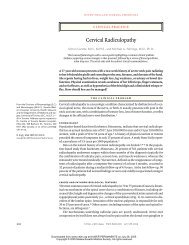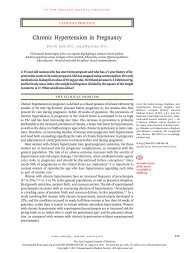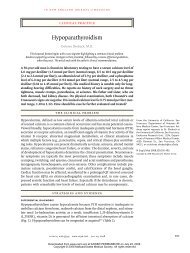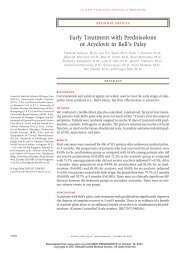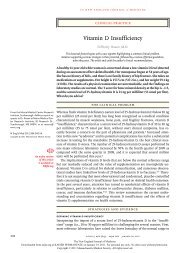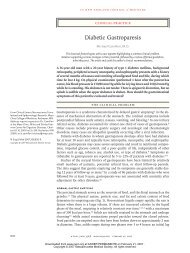Care of Transsexual Persons - Q-Notes for Adult Medicine
Care of Transsexual Persons - Q-Notes for Adult Medicine
Care of Transsexual Persons - Q-Notes for Adult Medicine
Create successful ePaper yourself
Turn your PDF publications into a flip-book with our unique Google optimized e-Paper software.
T h e n e w e ngl a nd j o u r na l o f m e dic i n e<br />
is not, parental support is <strong>of</strong> paramount importance.<br />
Follow-up should include anthropometric<br />
measurements, assessment <strong>of</strong> bone mineral density<br />
and metabolic measures (e.g., lipid and glucose<br />
levels and bone turnover), psychometric testing,<br />
and ongoing counseling.<br />
Limited observational data from juvenile transsexuals<br />
have indicated that gender dysphoria is<br />
reduced 45 and relationships and academic skills<br />
are improved 5,46 after early treatment <strong>for</strong> sex reassignment.<br />
Beginning treatment at the time <strong>of</strong><br />
puberty appears to be associated with better outcomes<br />
(e.g., in psychopathologic scores) than beginning<br />
in adulthood, by which time irreversible<br />
sex characteristics may pose lifelong barriers to<br />
successful sex reassignment. 16,17,46,47<br />
A r e a s <strong>of</strong> Uncerta in t y<br />
Although several studies have shown amelioration<br />
<strong>of</strong> gender dysphoria and improvements in social<br />
and sexual functioning in transsexuals who have<br />
undergone sex reassignment, none have conclusively<br />
demonstrated that medical interventions resolve<br />
gender dysphoria. 2,5,6 Comparative studies<br />
are lacking to in<strong>for</strong>m decision making regarding<br />
regimens and dosing <strong>of</strong> cross-sex hormones. Recommendations<br />
<strong>for</strong> management are based on expert<br />
opinion 11 ; studies <strong>of</strong> the efficacy and safety <strong>of</strong><br />
hormone preparations are lacking, as are dose–<br />
response studies <strong>of</strong> sex hormone preparations.<br />
Large, long-term studies are needed to provide<br />
data on the long-term risk <strong>of</strong> disease, 21,29,48 especially<br />
<strong>for</strong> cardiovascular disease 21 and cancer, 31<br />
which are <strong>of</strong> particular concern in older patients<br />
and in those who have had prolonged exposure to<br />
sex hormones. Data are also needed on how the<br />
administration <strong>of</strong> GnRH analogues followed by<br />
cross-sex hormonal treatment affects pubertal development.<br />
42 Unresolved questions are whether<br />
there is an age at which cross-sex hormonal treatment<br />
should be discontinued 21 and whether hormone<br />
replacement should be avoided in older<br />
male-to-female transsexuals.<br />
Guidelines from Pr<strong>of</strong>essiona l<br />
Socie ties<br />
Guidelines <strong>for</strong> the treatment <strong>of</strong> transsexuals have<br />
been <strong>for</strong>mulated by the World Pr<strong>of</strong>essional Association<br />
<strong>for</strong> Transgender Health and are published<br />
in its 2001 report, Standards <strong>of</strong> <strong>Care</strong> <strong>for</strong> Gender Identity<br />
Disorders. 1 These guidelines have been elaborated,<br />
with a special focus on cross-sex hormones, in the<br />
most recent guidelines from the Endocrine Society.<br />
11 The recommendations in this review are<br />
consistent with these guidelines.<br />
Conclusions a nd<br />
R ecommendations<br />
The person described in the vignette has gender<br />
dysphoria that is probably consistent with a diagnosis<br />
<strong>of</strong> gender identity disorder. The diagnosis<br />
must be verified by an experienced mental health<br />
pr<strong>of</strong>essional, with attention to eligibility and readiness<br />
<strong>for</strong> sex reassignment. The patient needs to<br />
understand that sex reassignment brings relief<br />
<strong>of</strong> gender dysphoria only — other psychological<br />
problems may remain. Expectations about physical<br />
appearance and life after sex reassignment<br />
must also be realistic. Because real-life experience<br />
is indispensable, a prerequisite <strong>for</strong> surgical<br />
sex reassignment is at least a year <strong>of</strong> experience<br />
living entirely as a member <strong>of</strong> the new sex, with<br />
complete habituation to the new behaviors and<br />
to the responses <strong>of</strong> others. Patients who follow<br />
this procedure rarely have regrets after sex reassignment.<br />
<strong>Persons</strong> undergoing sex reassignment can be<br />
reassured that serious short-term complications<br />
<strong>of</strong> cross-sex hormonal treatment appear to be<br />
uncommon. 21,49 However, longer-term effects on<br />
the risks <strong>of</strong> cardiovascular disease, metabolic<br />
disease, and cancer are not well charted.<br />
Dr. Gooren reports receiving consulting fees and compensation<br />
<strong>for</strong> travel from Bayer Schering Pharma. No other potential<br />
conflict <strong>of</strong> interest relevant to this article was reported.<br />
Disclosure <strong>for</strong>ms provided by the author are available with the<br />
full text <strong>of</strong> this article at NEJM.org.<br />
References<br />
1. The Harry Benjamin International<br />
Gender Dysphoria Association’s standards<br />
<strong>of</strong> care <strong>for</strong> gender identity disorders,<br />
sixth version. February 2001. (http://<br />
www.wpath.org/Documents2/socv6.pdf.)<br />
2. Cohen-Kettenis PT, Gooren LJ. <strong>Transsexual</strong>ism:<br />
a review <strong>of</strong> etiology, diagnosis<br />
and treatment. J Psychosom Res 1999;46:<br />
315-33.<br />
3. Cohen-Kettenis PT, Pfafflin F. The<br />
DSM diagnostic criteria <strong>for</strong> gender identity<br />
disorder in adolescents and adults.<br />
Arch Sex Behav 2010;39:499-513.<br />
4. Diagnostic and statistical manual <strong>of</strong><br />
mental disorders, 4th edition, text revision<br />
(DSM-IV-TR). Washington, DC: American<br />
Psychiatric Association, 2000.<br />
5. Smith YL, Van Goozen SH, Kuiper AJ,<br />
Cohen-Kettenis PT. Sex reassignment: outcomes<br />
and predictors <strong>of</strong> treatment <strong>for</strong> adolescent<br />
and adult transsexuals. Psychol<br />
Med 2005;35:89-99.<br />
6. Murad MH, Elamin MB, Garcia MZ, et<br />
al. Hormonal therapy and sex reassignment:<br />
a systematic review and meta-analysis <strong>of</strong><br />
quality <strong>of</strong> life and psychosocial outcomes.<br />
Clin Endocrinol (Oxf) 2010;72:214-31.<br />
1256<br />
n engl j med 364;13 nejm.org march 31, 2011<br />
The New England Journal <strong>of</strong> <strong>Medicine</strong><br />
Downloaded from nejm.org at KAISER PERMANENTE on March 30, 2011. For personal use only. No other uses without permission.<br />
Copyright © 2011 Massachusetts Medical Society. All rights reserved.






